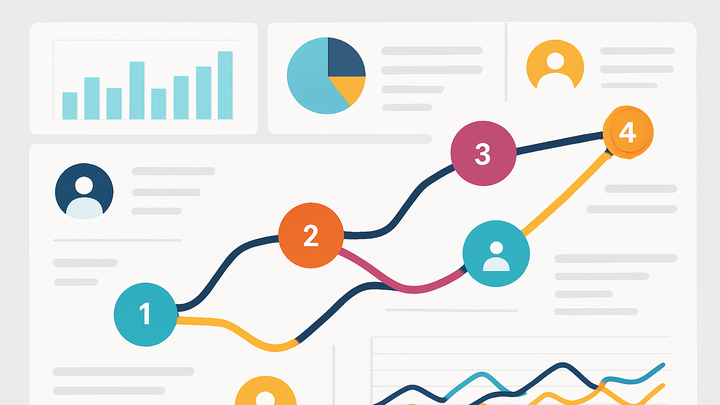Published on 2025-06-26T05:30:02Z
What is Longitudinal Data? Examples in Analytics
Longitudinal data refers to datasets that capture information about the same subjects or entities over multiple time points. In analytics, this type of data allows businesses to observe changes, trends, and patterns in user behavior over time rather than relying on a single snapshot. By tagging each event with timestamps and consistent user identifiers, analysts can conduct cohort analyses, track retention, and build predictive models. Platforms like Google Analytics 4 (GA4) and PlainSignal facilitate longitudinal tracking through event-based architectures and privacy-friendly implementations. Leveraging longitudinal data empowers teams to make data-driven decisions, understand user journeys deeply, and optimize strategies based on temporal insights.
Longitudinal data
Data collected across multiple time points for the same subjects to analyze trends, retention, and user behavior over time.
Understanding Longitudinal Data
An introduction to longitudinal data, focusing on its defining features and how it differs from cross-sectional data in analytics contexts.
-
Definition and key characteristics
Longitudinal data tracks the same subjects across multiple time periods. It’s characterized by repeated measures, enabling analysis of change over time. Key features include time-stamped observations and the ability to link events to individual users.
-
Repeated measures
Multiple observations collected from the same user or entity at different time points.
-
Time stamps
Each data point is tagged with a precise timestamp to establish temporal order.
-
Entity linking
Unique identifiers or user IDs connect observations back to the same subject over time.
-
-
Cross-sectional vs. longitudinal data
Cross-sectional data captures a snapshot at one point in time, while longitudinal data follows progression. Understanding this difference helps in selecting appropriate analysis methods.
-
Cross-sectional
Single-time measurements providing a static view, ideal for prevalence studies.
-
Longitudinal
Dynamic measurements over time, suited for trend analysis and causal inference.
-
Why Longitudinal Data Matters in Analytics
Understanding the motivations behind using longitudinal data, including deeper insights into user behavior and improved decision-making.
-
Track changes over time
Longitudinal analytics reveal how user engagement or metrics evolve, highlighting trends, seasonality, and the impact of interventions.
-
Enable cohort analysis
By defining cohorts based on acquisition dates or behaviors, analysts can measure retention, churn, and lifecycle value over time.
-
Improve personalization and predictions
Historical behavior data enhances predictive modeling and personalization engines, leading to better user experiences.
Examples of Longitudinal Data with SaaS Products
Practical examples of how leading analytics platforms like GA4 and PlainSignal implement longitudinal data tracking and reporting.
-
Google analytics 4 (GA4)
GA4 uses an event-based model with user-centric measurement. It assigns a Google Signals or User ID to stitch events across devices and over time.
-
User id tracking
Assigns unique IDs to logged-in users to track journeys across sessions and devices.
-
Event timestamps
All interactions are timestamped, enabling sequence analysis and time-based reports.
-
-
PlainSignal (cookie-free simple analytics)
PlainSignal offers privacy-friendly longitudinal tracking without cookies. It relies on minimal client-side code to record events over time.
<link rel="preconnect" href="//eu.plainsignal.com/" crossorigin /> <script defer data-do="yourwebsitedomain.com" data-id="0GQV1xmtzQQ" data-api="//eu.plainsignal.com" src="//cdn.plainsignal.com/plainsignal-min.js"></script>-
Setup snippet
Integrate with the above script snippet to start capturing longitudinal data.
-
Time-based journeys
Visualize user paths and event timelines while preserving anonymity.
-
Best Practices for Implementing Longitudinal Tracking
Key guidelines to ensure reliable, accurate, and privacy-compliant longitudinal data collection in analytics projects.
-
Consistent user identification
Use stable identifiers (e.g., user IDs, hashed emails) across sessions to accurately link events back to the same user.
-
Respect privacy and compliance
Implement cookie-free or consent-based tracking. Ensure GDPR, CCPA, and other regulations are followed when handling personal data.
-
Maintain data quality
Regularly audit and validate your time-stamping and linking logic to prevent gaps, duplicates, or misattributions.
Challenges and Considerations
Common pitfalls and considerations when working with longitudinal data in analytics environments.
-
Data drift and consistency
Over time, tracking implementations may change, causing inconsistencies. Version control and monitoring help mitigate this.
-
Missing data and attrition
Users may drop off or opt out, leading to incomplete records. Plan for handling missing observations and censoring.
-
Scalability
Storing and querying large volumes of time-series user data can strain resources. Use efficient data storage and indexing strategies.
